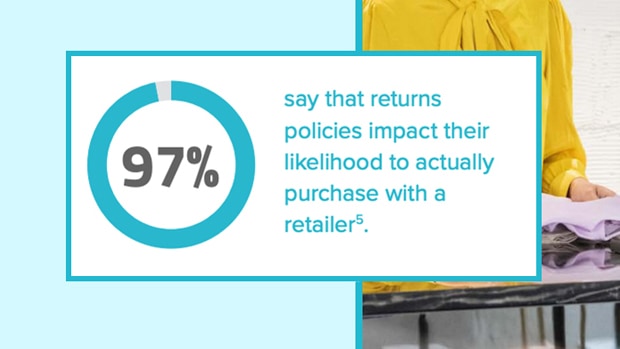A merchant’s customer experience doesn’t end at the point of purchase. Today, customers want easy, seamless returns experiences, and in-store and online returns options are becoming an increasingly crucial requirement of the shopping experience. 97% of shoppers say that a company’s returns policy impacts their likelihood to actually purchase with a retailer, and 23% of online shoppers will actually abandon their shopping carts if they’re presented with poor returns options.
Offering best-in-class returns policies is a competitive advantage for merchants to stand out in a crowded market as consumer expectations continue to rise. This is especially true during the recent global pandemic as returns are now an even larger component of the customer experience, and merchants need to be extra accommodating on their return policies – e.g. extending return windows, online initiation of returns, etc. – to maintain customer loyalty. However, as return offerings are becoming a larger requirement for consumers, they’re also becoming a growing target for abuse and fraud. Returns abuse occurs when legitimate customers (or what may look like legitimate customers) exploit a merchant’s returns policy for their own gain, and this is a growing issue for retailers that costs an estimated $24 billion annually.
There are many different types of returns abuse that merchants face, including:
- Wardrobing/Renting: Abusers purchase items, wear or use them, and then return the items back to the store for a refund.
- Returns Fraud: Abusers return a different (and less valuable) item while collecting the value of the original item.
- “Gift With Purchase” Abuse: Abusers add items to their order to qualify for a “free gift with purchase” offer, and then return their order while keeping the free gift
- And more
The common denominator across all types of returns abuse and fraud is that they have significant impacts on a merchant’s business and bottom-line. Abusive returns remove inventory from stock that could have been sold to legitimate customers. Merchants are also saddled with the operational costs and overhead of abusive returns – processing, shipping, restocking, and more – that cut into their bottom-line. Additionally, in some cases, the costs associated with returns abuse can actually make it financially infeasible for merchants to support a best-in-class returns program, resulting in a poor customer experience.
Forter’s Returns Abuse Protection solution protects merchants from returns abuse and fraud by providing merchants with the ability to accurately approve legitimate returns, detect abusive users, and enforce their business policies in real-time. Forter partners with each merchant to tailor the solution to their particular business needs and requirements. Forter’s platform can then identify returns abusers, even when they’re attempting to hide their identity or behavior, and Forter provides real-time decisions at any touchpoint (e.g. returns initiation, purchase) so that merchants can enforce their business policies. Lastly, Forter can also flag abusive accounts with a recommended action, so merchants can also enforce their policies at an account level.
With Forter, merchants can now deliver a best-in-class returns offering without risk, so they can protect their profits while enhancing their overall customer experience.
To learn more about Forter’s Returns Abuse Solution and how you can deliver customer-friendly return policies without risk, visit here.






